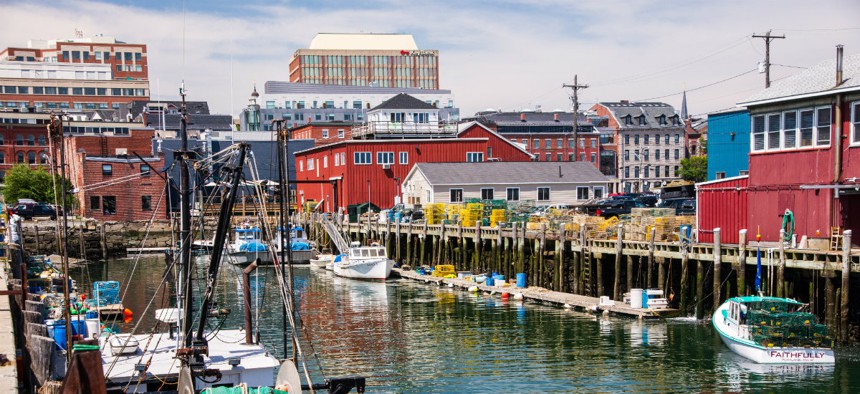White People Do Sell Drugs, Despite What Maine's Governor Says

Portland, Maine.
Governor Paul LePage believes black and Latino drug dealers are polluting the white state of Maine.
There’s a growing call for Maine Governor Paul LePage to resign after embarrassing his state with a string of racist rants and a profanity-laced threatto a public official who called the governor out on his bigotry.
It started back in January, when LePage vented at a town hall meeting about drug dealers coming from Connecticut and New York to sell heroin and impregnate white women. If the racism there wasn’t clear, he clarified it at another town hall on August 24, where he waved a binder that he said was full of cases of “black and Hispanic people” from out of state coming to Maine to sell drugs. He then doubled down on those comments at a press conference after the town hall, stating that “the enemy right now … are people of color or people of Hispanic origin.”
When State Representative Drew Gattine called out LePage publicly for his racism, the governor left a voicemail on Gattine’s phone cursing him out andchallenging him to a duel. LePage has since given a sorry-not-sorry apology to Gattine, but he has not apologized for his remarks about black and Latino people.
LePage said that “when it comes to meth labs, they’re essentially all Maine white people … When it comes to the heroin epidemic, it’s just the opposite,” touting his binder full of news clippings of Maine drug arrests as proof. His refusal to take back those racist comments, along with his other erratic behavior, has led some in the state to wonder if the governor is himself on drugs.
The governor’s comments might be ignored if they didn’t have such dire consequences for criminal justice policy in the U.S. There is already a perception that the use and sale of drugs in the country is an exclusively black and Latino enterprise. A number of draconian prison-sentencing laws were created during the 1970s era of President Richard Nixon’s War on Drugs, and through President Bill Clinton’s “tough on crime” initiatives of the 1990s. Such policies decimated entire black communities—despite the fact that white people are known to sell and use drugs at the same rates, if not higher.
LePage’s public remarks about race and drug crimes, of course, only serve to perpetuate these stereotypes. Maine has a 95 percent white population, making it the whitest state in the country, and his remarks attempt to preserve the sanctity of this whiteness by casting drug crime as having a black face. But all it takes is a cursory review of drug arrests (and, more importantly, convictions) in Maine to show that LePage’s racial boogeymen theory is untrue.
According to meeting notes from a convening of the Maine Anti-Heroin/Opiate Initiative in December 2015, only 16 percent of Drug Enforcement Agency arrestees are from outside of Maine. Additional DEA info in the Bureau of Justice Statistics only provides data for the years 1980 to 2012. But according to what Maine’s DEA reported to BJS, only about 11 percent of drug-sale and manufacturing arrests were of African Americans in 2012, with no data for Latinos at all. Meanwhile, the BJS data also show that white arrests in this category far outnumber those for African Americans. The Bangor Daily Newsreported that 70 percent of Maine state prison inmates being held for drug trafficking crimes are white.
Complete crime data from any law enforcement agency is difficult to come by. The U.S. Attorney’s office in Maine told CityLab that it doesn’t collect demographic data on its drug cases because “it’s not relevant to what we do.”
LePage believes he has the empirical evidence on this matter, however, collected neatly in his binder. When the Maine chapter of the ACLU made a public information request on August 25 for LePage’s binder, the governor’s office replied that this would take weeks. The Maine ACLU executive director Alison Beyea says that if black people do constitute the bulk of those arrested for drug trafficking as LePage alleges, that suggests racial profiling.
But again, even the limited evidence available does not support LePage’s theories on out-of-state black and Latino dealers. A scan of press releases from the U.S. Attorney’s office in Maine—the agency that would capture the larger-volume drug pushers—turns up numerous white drug dealers. Here are just a few:
- On August 22, Roger Belanger and his daughter Kelli Mujo were convicted of “conspiring to distribute and possess with the intent to distribute controlled substances and maintaining a drug involved premise.” They dealt mainly cocaine and the heroin-like opiate oxycodone through adrug-smuggling operation for 12 years.
- In July, Jesse Roy was sentenced to nearly 14 years in prison for trafficking heroin and the deadly opiate fentanyl.
- In July, Matthew Mennealy was sentenced to 84 months in prison for distributing heroin, oxycodone, and cocaine across Maine, with a team of fellow white pushers.
There’s plenty more where those came from. Not to mention the two men listed on the Maine DEA’s most wanted list: White guys.
LePage’s narcotic fiction about black men from New York slinging drugs and turning out white girls makes for a well-worn, tiresome movie storyline. But when this story is sold to constituents and voters by a state’s highest office, it leads to laws and policies that cause irreparable damage to communities of color. LePage might want to spend some time in a prison in his state, so that he can see for himself what the true color of crime is there.
Brentin Mock is a staff writer at CityLab, where this article was originally published.
NEXT STORY: California's Open Data Portal Goes Open Source for the Apps





